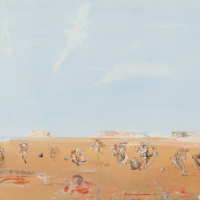37. FRED WILLIAMS

That Fred Williams is in the first rank of landscape painters internationally needs little discussion. To investigate Williams world of painting is to see an artist so deeply engaged with the subject of landscape that the boast of being-best or indeed world-class is rendered obsolete.
The discussion here centres on observation, the look and put of Williams gouaches that change the gears of his machinery - his technique - up and down a scale that adapts to place, to light and topography. It is being present to each moment and sensation that sets Williams apart from the rest who earnestly work with this paradigm. Landscape painters conform to a scene and a personal remit, but we can only be surprised when perceptual changes are at play.
Fred Williams achieved this and by 1965 had changed the course of Australian landscape painting. He was not willing to settle on this breakthrough and pursued new locations combing painting outdoors in gouache on paper, and oil, with many works being completed in the studio. To this was added printmaking until his vision expanded even further. It would change how Australians saw their immediate country and importantly how they thought about landscape.
Tibooburra Landscape 1967 is a welcome addition to the current sale. It is a gouache that Fred Williams completed when he and fellow painter Clifton Pugh travelled to Broken Hill and to Tibooburra in October of the same year. What he experienced was very washed-out but very alive.1 This was new terrain for Williams and a hook upon which to hang a new argument about landscape and how to paint it.
Tibooburra Landscape is both pretty in detail and vast in sweep. This painterly conceit of near and far, of pinpoint detail and colour is challenging. Williams had already remarked about the colour, the pure sulphur and Lilac color of it- reminded me of Persian paintings.2 And the analogy does ring true when we view Tibooburra Landscape. It is Williams in the landscape capturing the finer close-up detail against the ineffable distance in which the rock formations sit.
Footnotes:
1. Mollison, J., A Singular Vision: The Art of Fred Williams, Australian National Gallery, Canberra, 1989, p.123
2. Ibid., p.123
Brett Ballard